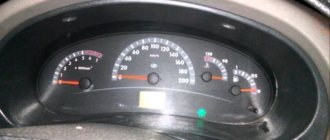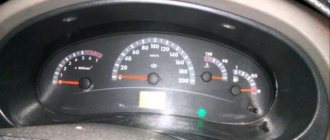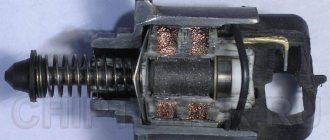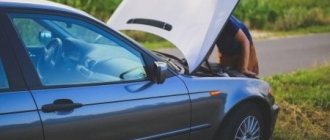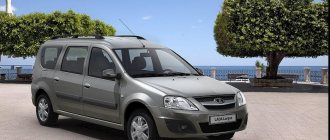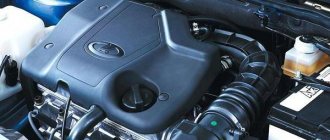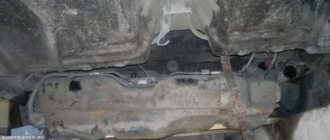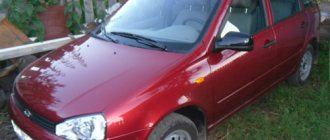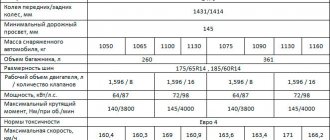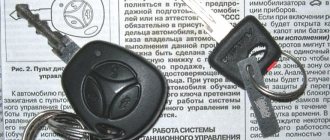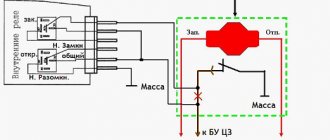I think no one will argue with me if I say that domestic cars are far from being comparable to foreign car brands. No one, not even the most patriotic person, will argue that the Lada Kalina is far from BMW or Mercedes.
Of course, it’s not the same price category at all, you say, but even cheaper foreign cars are usually superior to ours.
It's not a matter of beautiful design or a comfortable interior, but the fact that most of our cars can be sent straight from the assembly line for repairs.
So, you are the happy owner of a domestic car, and what should you do if yours, let it be a Lada Kalina, for example, does not start?
There are many reasons why a car refuses to start. Let's consider, of course, only the main ones, those that can be noticed and corrected on your own, the rest will be left to the “STO workers”, not because they also need to eat something, but because if you start fixing something that you don’t know how to fix, you can end up making it worse .
Repair gurus may pass by, this is a guide for the standard, average person, not a repair specialist, but at least who knows which side to grab the wrench by.
Immobilizer
If the car refuses to start, then this is one of the possible reasons. You can notice problems in the operation of this system yourself. If the corresponding icon blinks on the dashboard and a characteristic beeping sound is heard, then you should read the operating instructions. If the Lada Kalina does not start, the immobilizer is a common problem. The problem is not easy to fix. In the instructions for the car, the manufacturer indicates the decoding of sounds and blinking lights - the car owner needs to count the time between flashes, the number of buzzer signals, and then read what the manufacturer writes about this.
Conclusions or what to do?
As you can see, of all the possible options, you can even get to the service yourself only in the first cases considered. If the starter turns, but the car does not start, then most likely (unless you are a car mechanic) you will have to call for help.
If your starter does not work or the battery is simply dead , and the car has a manual transmission, you can start it with a pusher. To do this, you will need the help of passers-by or another car.
Never try to push start a car with an automatic transmission! This will only break it.
How to start a car with a pushrod
You need to: turn on the ignition, depress the clutch and start towing or pushing the car (it is advisable to pick up at least a speed of 10 km/h). Engage second gear and release the clutch. The car will jerk and start. Depress the clutch again and put the gearbox in neutral. Thank your rescuers and DO NOT turn off the car!
If the reason is a dead battery due to forgotten electrical appliances being turned on, then driving for 15-20 minutes will be enough for the battery to charge again and be enough for the next engine start.
And if you were unable to start because of the starter, then we advise you to go to a service station and do not turn off the car, otherwise you will have to start it again with outside help.
Good luck on the roads and keep an eye on your friend's technical condition.
How and why the immobilizer fails
Let's dwell on this topic in a little more detail. The thing is that the ECU controller on this model is located under the heater radiator. In second-generation models, the controller was moved.
First of all, when exposed to liquid, the output switch burns out. The chip can be re-soldered, but after such repairs the problems will go away for literally two months, and then they will appear again. The heater radiator will need to be replaced. If this problem exists, then experts recommend installing a new controller between the engine compartment partition and the stove.
Now about the immobilizer - in Kalina cars the manufacturer installs APS-6 immobilizers. In very rare cases, these devices fail on their own. Often, the problem is hidden in the wiring or control panel. The key fob body is held together with one self-tapping screw - the screw can be overtightened or undertightened. A crack appears on the remote device chip between the transponder contacts. In this case, if the Kalina does not start, only a spare or training key, or replacing the remote control will help.
Starter
The immobilizer has been checked and does not give any alarms, but the engine still does not want to start. Another reason for this behavior is the starter. It’s easy to notice a problem with the starter – you won’t hear the characteristic sound of the engine starting. The mechanism simply does not spin, which means the engine will not be able to start. Everything is clear here - you need to remove and check the starter.
If the Kalina does not start, the starter does not turn, then the first reason may be the battery. It may simply be discharged. If the lights in the cabin and on the dashboard are not lit, the driver will be able to immediately notice this. However, it often happens that everything is in order, but the starter still does not work. For diagnostics, turn on the high beams and get out of the car. Dim headlights are due to the battery. It is discharged, but only to a critical level, when there is not enough power to turn the starter.
If the Kalina does not start, the starter does not turn, the best way out of this situation is to charge the battery. But if the headlights are bright in high beam mode and are not going to dim, then you will have to look for the reason elsewhere.
Poor quality fuel
Spark plugs can also flood due to bad gasoline. This is another reason why the engine does not start. Very often, condensation forms in winter and clogs the coarse filter. To avoid this, periodically add pure alcohol to the tank in winter.
It smokes, sneezes, smokes like a snake Gorynych, this often happens in our time, but, as a rule, people have some remnants of conscience and they try not to reduce gasoline to a non-flammable state.
The car can even run on this kind of gasoline, the only problem is that it is absolutely not useful for the engine. To avoid this, refuel at large chain gas stations.
They, as a rule, monitor their reputation and do not allow this to happen, but if it turns out that you have filled in burnt gasoline, and even so much that the car does not want to start, you can drain the gasoline and fill in another, road gas, or if there is not much left , you can fill in more good 95 gasoline and its mixture with palenka will be more or less normal.
Of course, there are severe cases when filters and injectors become clogged and they have to be washed out for a long time and tediously (or whatever is easier to change), but this happens mainly when buying gasoline from some garage “oil workers”.
It’s quite easy to protect yourself from them - just refuel at trusted places and under no circumstances buy gasoline from any garage gas dealers. In principle, they are not such a common occurrence now, but they still occur, and people buy gasoline from them because it is cheaper, but it is better not to do this, the stingy pays twice - an immutable truth.
And if you really had to buy such a piece of water, at least filter it, there is no need to clog the filter with nozzles.
Starter or wiring problems
You can use a multimeter to test the wiring. The red wire is connected to the starter contact, the black wire to ground. In a normal situation, the device will show from 12.5 to 14.5 V. If the reading is less or even zero, then there is something wrong with the wiring.
The first step is to clean the contacts, check the integrity of the wires and fuses.
This is another popular problem when Kalina does not start. ECUs are the “brains” of the car; they themselves are quite reliable, and if you don’t touch them, then no problems will happen. However, most often the ECU is flooded.
This often happens when antifreeze leaks. This has already been discussed in the section on the immobilizer. When installing an alarm system or when pulling car wires, they forget to install the plugs - water gets into the ECU. Repairing an electronic unit is a futile task.
Timing problems
The timing belt is responsible for the operation of the engine in the car. Sometimes a metal chain is installed instead of a belt. Both are responsible for rotating the crankshaft and camshaft.
When using a car, every part wears out over time. The timing belt is no exception. Under constant load, it wears out and can rupture. Such a violation will lead to damage to the engine valves, and subsequently to its breakdown. And then a problem arises: the starter turns, the car does not start. What to do? A complete timing belt repair or valve belt replacement can be quite expensive. Therefore, to prevent such a problem from happening, it is advisable to change the belt every 2 years (this is approximately 60,000 km).
You shouldn’t delay replacing it if you don’t want to harm your beloved car. Leave the belt replacement to professionals to avoid stretching.
Gasoline pump
The vagaries of the fuel pump are often observed, especially in winter. The starter works, but the Kalina car refuses to start, the fuel pump cannot be heard, and an exclamation mark may flash on the dashboard.
First of all, check the pressure in the fuel system. To do this, open the hood and look for the cap on the ramp with the injectors. You can see the nipple there - if you press it, fuel should spray out. If it splashes, then the problem is not with the fuel pump.
Another reason is the relay. There is a cover in the transmission tunnel on the passenger side. It contains power coils. To eliminate the malfunction, just knock or warm them up.
If the fuel pump does not work, then you need to get to it and check the voltage. If the multimeter shows about 12 V, then the fuel pump is working. If not, then it is worth checking the fuses, as well as the relays.
Crankshaft sensor
Sometimes it happens that the car starts normally when cold, but if you turn off the engine and after some time try to start it again, nothing will work.
Sometimes the car just won't start. The starter works, the fuel pump pumps, the spark plugs and brains are in order, in this case you should check the crankshaft sensor, perhaps it is gradually dying.
To do this, remove the sensor, connect a multi-meter to the connectors in voltmeter mode and quickly pump it in front of its end with a screwdriver; there should be voltage surges.
Another way is to remove the sensor and measure its resistance, with the same multi-meter, set it to a continuity test and ring the two contacts of the sensor, it should show approximately 750 Ohms
If there are no jumps, change the sensor. If there are surges, you can try to check if there is dust or dirt under the sensor, if the end is dirty; if after cleaning the engine still does not want to start, we try to install a new sensor, since it is quite inexpensive.
If after installing a new sensor the situation has not improved, then it is not the problem. Another easiest way to determine that the sensor is faulty is to look at the tachometer; as a rule, if there is a fault, the speed does not twitch when trying to start.
The main culprits of the engine not starting
So what to do if Kalina does not start and does not turn the starter? There are many reasons. Some problems can be fixed on your own, while others can only be fixed at specialized service stations.
Immobilizer
Not all Kalinas have the immobilizer activated from the factory, but you can disable it if you are afraid of its glitches. If you do not have it activated, then this problem should not affect you.
This may be the first reason why the car won't start. You can fix it yourself. If the immobilizer starts blinking, then in order to understand the specific cause of the malfunction you need to sit down and read the manual: what each light means, as well as the frequency of flashes and buzzers. In the cold season, the car can only be started after 5-6 times.
The photo shows a red key for clarity. The red block in the photo is a memory element for the immobilizer; it can become out of sync or break.
This problem can be solved by reflashing the key.
Starter
In the case when the previous system is in good condition, another reason why the car does not start may be the starter. Only a deaf person would fail to notice that this unit is not working.
Starter under the hood of Kalina. Check the power to the starter, circled in red.
Control unit (ECU)
This is also a common reason why the engine will not start. Usually, if you don't touch it, there are no problems with it. Often the unit can fail when it is flooded with water. This is a design flaw, or rather a flaw in the location of the ECU (a known problem with Kalin).
The ECU in Kalina is located at the bottom; due to leaks during rain, it can easily be flooded with water
In this case, the block will have to be replaced completely. To protect yourself, you should insulate it well or move it to another place under the hood. You cannot wrap the block in polyethylene, as it will fail due to condensation.
Candles
They are usually flooded in the cold season. This can also happen when the battery is weak. In this case, you need to dry the candles. They can be cleaned from carbon deposits with a toothbrush. The gap should also be kept within 0.8-1 millimeter. You can also use a hairdryer. If you have spare spark plugs, you can replace them.
Fuel
It can also be the reason why the engine will not start. To protect yourself from low-quality fuel, you need to refuel your car only at time-tested gas stations.
Fuel pump and relay
The fuel pump is universal and fits all models of the VAZ family.
If the engine does not start when the starter cranks the engine, then the cause may be the fuel pump and it needs to be replaced. You need to open the hood and find the cap to the left of the injectors. When you press it, gasoline should spray out. When gasoline enters the engine, it is not the fuel pump. The relay may fail.
Main reasons
The engine does not start the first time
Kalina has a fairly common reason that it does not start the first time. This is due to design, wear and tear and electrical issues. But, it is worth breaking the problems into categories and considering them in more detail. So, let's look at the main categories into which this malfunction is divided:
- Problem with the fuel system.
- The reason is the ignition.
- Failure of timing elements.
- The problem is in the operation of electrical circuits and the ECU.
When everything is sorted out into the causes, it is worth considering them in more detail and how to eliminate them on the car.
Fuel system
The first reason that a car may not start the first time is the fuel system. Insufficient fuel or too much gasoline becomes a problem. In this case, the starter turns, but starting is difficult. If the starter does not turn and the immobilizer icon is flashing, then the problem is already on the immobilizer side.
Fuel pump wear
A failure of the fuel pump or a clogged fuel filter can cause the pressure in the fuel line to be insufficient and the mixture to be lean. Accordingly, the small amount of fuel in the combustion chambers is not enough to start the engine. If too much fuel mixture is supplied, the spark plugs are simply thrown and there is no spark to ignite, which causes the engine to not start.
Ignition
The second reason for poor starting is a malfunction of the ignition system. The problem may lie in the following nodes:
- Ignition switch malfunction.
- Breakdown in high-voltage wires.
- Spark plugs are worn out or dirty.
When considering the problem, it is necessary, first of all, to pay attention to the spark plugs, clean them and adjust the gaps using a feeler gauge.
Next, you need to check the ignition wires, resistance and insulation damage. If necessary, it is worth replacing failed products.
Lada Kalina won't start
Added by avtorin on 01/06/2018
Lada Kalina will not start - a common problem for car owners, especially after 100 thousand miles. The reasons can be very different, and so can the solutions. Why the Lada Kalina won’t start, as well as small diagnostic tricks, are in the article.
The content of the article:
All cases when Kalina does not start can be divided into several groups. So to speak,
what is needed in order to narrow down the troubleshooting range as much as possible. In addition, if you understand individual points, then it is easier to imagine the operation of the system in general.
No gasoline
Of course, for normal mixture formation you need fuel and a spark, in the case of gasoline engines. Therefore, let's pay attention to this point.
So, the first thing you should pay attention to if the Lada Kalina does not start is the operation of the fuel pump when the ignition is turned on. It should work, especially if the car was parked before. If the fuel pump does not work, first of all, check the integrity of the fuse; it is located next to the diagnostic connector, on the central tunnel. We need the middle one.
The next step is to check the fuel pump relay. It is very easy to check - turn on the ignition and listen for a click. If there is one, then feel free to go under the back seat, arm yourself with a multimeter or test light, and then connect to the connector instead of the fuel pump. Gray is a plus, black is mass. We turn on the ignition, the lamp should light up, if it doesn’t light up, then we look for a break along the path from the fuse block to the tank. But in general, most likely, it will catch fire, then we change the pump and the Lada Kalina starts and drives.
But it also happens that the Lada Kalina does not start, but the fuel pump works. It is worth clarifying that a working fuel pump does not mean that fuel is getting into the cylinders. If the starter turns, unscrew the spark plugs and look, they should be damp. If they are dry, then turn on the ignition, unscrew the cap on the fuel rail and briefly press the spool. It should hit you with a stream of gasoline.
If the Lada Kalina does not start, there is pressure in the fuel rail, this means that the injectors simply do not open. First, let's start with something simple - look at the crankshaft position sensor. The fact is that the control unit receives pulse signals from it, after which, in accordance with these signals, it sends pulses to the injectors. They are controlled by a minus, that is, when the ignition is turned on, they should constantly receive a plus through a common black and pink wire. There is almost always power on it, if not, we look for a break to the ECU.
If there is power, look at the crankshaft position sensor and the drive disc on the pulley. It happens, it comes off the damper and scrolls. In this case, the control unit does not understand what position the crankshaft is in, and a discrepancy with the camshaft position sensor leads to the Kalina not starting. We read how to check the crankshaft position sensor, as well as the connector to it, this is generally a disease.
As has already become clear, the first thing to do if Kalina does not start is to check the fuses and unscrew the spark plugs. They will tell you if there is fuel. Now let's consider a situation when the Lada Kalina does not start, the starter turns, there is gasoline, but there is no spark.
This is easy to check. We take either a spare spark plug or unscrew it from the cylinder. Then we put one candlestick on it and place it on the block head. Next, ask an assistant to turn the starter and watch for a spark.
Accordingly, diagnostics of the Lada Kalina ignition system is divided into several stages. Firstly, look at the gap in the spark plugs, it should be 1.1 mm. The best spark plugs for the Kalinovsky eight-valve engine are A17DVRM. They are cheap, 300 rubles per set, but they do not last more than 15 thousand. On the other hand, at this price they can be changed every 10 thousand. In return you will get stable starting, smooth operation and good traction.
Then we take a multimeter and check the resistance of the high-voltage wires. It should not exceed 10 kOhm on the longest and 5 kOhm on the shortest wire. Well, now the most interesting thing - the ignition module. Of course, ideally it should be diagnosed using a motor tester, but not every city has one. Therefore, to begin with, we remove the chip from the module, insert the multimeter probe into the central wire, then the second one to ground and turn on the ignition. It should be 12 volts. If not, we look for a break with the ECU or change the ECU.
If we are talking about an ignition module with a 4-pin block, then the voltage is measured on the first or second pin. Next, we measure the resistance of the primary coil (where the chip fits). It should be about 1.2 kOhm; it’s unlikely to be measured more accurately. Then we measure the resistance of the secondary winding of the coils. It should be approximately the same, but there is no exact figure. Each manufacturer has its own and can vary from 7 to 12 kOhm.
There is a spark, there is gasoline, the starter turns
In this case, it is unlikely that there is a problem with mixture formation. Most often, the problem lies in decreased compression due to wheel wear or valve burnout. Normal compression should be at least 12 atmospheres. Again, you also need to look at the DPKV, as well as the master disk. Of course, it is easier to determine such moments using a scanner, at least an ELM.
Lada Kalina does not start, the starter does not turn
In this case, first of all, you need to find out the battery voltage and bring it back to normal. Next, turn the key and listen to see if the relay clicks. If it clicks, it means that voltage is supplied to it from the ignition switch. If not, it is better to replace the starter relay with a known good one.
If the Lada Kalina does not start, the starter clicks but does not turn, then first you should try knocking on the starter while an assistant clicks it. Most likely the starter will seize at some point. In this case, you need to disassemble it and change the brushes, as well as clean the spots on the solenoid relay.
Car starting process
To narrow down the reasons why the engine does not start, consider the process of starting a car. You need to better understand what happens when you turn the ignition key.
What happens on a properly running car?:
- You sit behind the wheel and insert the ignition key into the ignition.
- Turn the key to the first position - turn on the ignition, the lights on the instrument panel light up, and an internal test occurs.
- Turn the key further and the electric starter starts working, which in turn spins up the engine. It's easy to hear by ear.
- The next moment you hear that the engine has started, you must release the key, which will return to its original position. The engine is running and you are ready to start driving.
A number of things can go wrong during the engine starting process and we need to help you identify where the problem is in order to determine what needs to be done to resolve the situation.
Communities › VAZ: Repair and Improvement › Forum › Kalina won’t start
Hello everyone, this morning the car refused to start. I was late for work, so I didn’t take a long time to figure it out and went on my own. The symptoms are as follows: the starter does not turn or click, the fuel pump pumps, the voltage on the battery is 10.4V, the lights are on, the radio is playing, the heater seems to work uncertainly (it feels like it is spinning weaker at first), the checkbox does not light up. What's wrong with the starter? Is the retractor dead? I'll get home from work and try to light a cigarette. How to check and what to use for differential diagnosis? Thanks guys in advance.
Connect the retractor terminal and + coming to the starter together; if it turns on, then either the ignition switch or the starter relay.
OK, thank you. I couldn’t do it right away - the tool is in the trunk, but it only opens with a button.
battery... (and no matter how you twist it, the ECU will not give the command to start if there is less than 10V in the on-board network - it simply has a pass-through transistor responsible for powering the chip will not open...) p.s. Also: does the light on the panel light up and is there a signal coming from the APS? if not, then look for the reason in the battery and starter... (possibly a lock...)
battery... (and no matter how you twist it, the ECU will not give the command to start if there is less than 10V in the on-board network - it simply has a pass-through transistor responsible for powering the chip will not open...) p.s. Also: does the light on the panel light up and is there a signal coming from the APS? if not, then look for the reason in the battery and starter... (possibly a lock...)
Well, the voltage is not less than 10, but 10.4
when starting the starter you will have less... from 6 to 9 V
But for this to happen, the retractor must work.
I’ll just type this out here, maybe it will help...
Diagnostics of the APS-6 immobilizer using a buzzer sound and an immobilizer indicator. When the system is in good condition, the immobilizer indicator does not light up and there are no buzzer signals. If, when you turn on the ignition, the immobilizer indicator lights up with a constant light or starts flashing, and after about 10 seconds the immobilizer buzzer sounds and the same signal is repeated after another 10 seconds, this means that the immobilizer is either untrained or there is a malfunction in the immobilizer system. The number of beeps and indicator signals indicates the type of malfunction.
1. If the buzzer sounds 1 time and the immobilizer indicator flashes, the diagnosis is “The key cannot be read.” Possible causes: 1.1 Malfunctions of the transponder circuit – this group of malfunctions is characterized by the absence of a “signal about the key left in the ignition lock” when the ignition is turned off and the driver’s door is open. 1.1.1 Malfunction in the ignition switch communication coil circuit. Measure the resistance of the communication coil between the contacts of the 2 black terminal block from the ignition switch, which should be within 6 - 8 Ohms. If the coil resistance is normal, check the continuity of the circuit between the 2-terminal block to the communication coil and pins 4 and 5 of connector X2 of the electrical package unit. 1.1.2 There is no transponder in the key. In the training key - check the presence of a transponder and its designation, it should be PCF7936AS. If there is no transponder, take a “clean” training key and a “clean” engine control system controller (ECSC) and retrain the immobilizer system. 1.1.3 The transponder in the key is faulty; it is detected during pre-sale preparation at PSSS. In the training key - you need to take a “clean” training key and retrain the immobilizer system. In a working key with a remote control (RC), you need to replace the remote control with a “clean” one and retrain the immobilizer system. 1.1.4 Malfunction of the input transponder circuit of the APS-6 unit - it is necessary to replace the APS-6 unit and retrain the immobilizer system. 1.2 “Alien” remote control – this malfunction is characterized by the presence of a “signal about the key left in the ignition switch” when the ignition is turned off and the driver’s door is open. It is necessary to replace the remote control with a “clean” one and retrain the immobilizer system.
( January 7.2). 2.2 Malfunction of circuits in the APS-6 or KSUD block on the W line - to identify a faulty product, it is necessary to carry out a test replacement of them one by one. If after replacing the product the fault code does not recur, it must be replaced. 2.3 There is no supply voltage on the APS-6 or KSUD unit. Check the presence of voltage at the contacts of the KSUD M7.9.7 (January 7.2): a) contact “12” – power from terminal “30” of the ignition switch; b) contact “13” – power supply from terminal “15” of the ignition switch; c) contacts “44”, “63” – power supply from terminal “30” of the ignition switch after the main relay.
3. If 3 buzzer beeps sound and the immobilizer indicator is constantly on or blinking - the diagnosis “The code of the read key is not in the APS memory.” Possible reasons: 3.1 If, after turning on the ignition, the immobilizer indicator lights up continuously for 20 seconds and 3 buzzer sounds sound, then the immobilization system has not been trained, the system should be trained. 3.2 If, after turning on the ignition with the training key, the immobilizer indicator flashes and 3 buzzer signals sound, then the APS-6 unit is “foreign” or the key is “foreign”. 3.2.1 “Alien” block APS-6. If the APS-6 unit turns out to be “foreign”, to restore functionality it is necessary to retrain the system with a “own” training key for the KSUD. 3.2.2 “Alien” training key. If the training key turns out to be “foreign”, to restore functionality you need to take a “clean” training key and a “clean” ICS and retrain the immobilizer system.
4. If 4 buzzer beeps sound and the immobilizer indicator flashes, the diagnosis “ECS does not confirm permission to start the engine.” This means that the KSUD was previously trained with a different system; it is necessary to replace the KSUD with a “clean” one and retrain the immobilizer system.
5. If, after turning on the ignition, the immobilizer indicator lights up for 20 seconds and the buzzer does not sound, then the immobilizer is trained with its keys, but the ACS is not trained. The system needs to be retrained.
The car starts and immediately stalls
You start the engine, it starts its work and literally calms down after a couple of seconds. This can baffle even an experienced driver. But don’t worry ahead of time. To quickly identify a breakdown:
- Check the condition of the ignition coil. The electrical connections may be damaged or loose.
- Make sure that the connections between the intake tract elements are completely sealed.
- Measure the pressure in the fuel rail - make sure that its value is equal to the norm.
Again, the entire engine control system may be faulty. In this case, you will have to carry out a full diagnosis. It is best to entrust this to professional craftsmen by contacting a car service.
What to do: Lada Kalina won’t start
Stylish crossover Kalina
A lot of time has passed since AvtoVAZ announced the launch of a new project called Lada Kalina. Grandiose advertising and hope for a bright future did their job: millions of Russians, out of patriotic feelings, decided to choose the domestic Kalina, discarding numerous projects by Renault, Volkswagen and other factories positioning reliability and quality. But the joy was short-lived.
Already in the first months, Kalina did not show her best side, showing a capricious disposition. And it turned out that Kalina’s owners began to spend more time in the garage doing repair work than on trips. Engineers know their shortcomings and try in every possible way to get rid of them in each next generation of cars, to come up with something to increase the reliability of the car.
But for some reason the results are still little noticeable. As before, the car cannot please you with its endurance and wear resistance. The most unpleasant problem is that Kalina does not start from time to time. To return the machine to working order, it is necessary to find out the causes of the malfunction, and there are many of them. So, let's try to figure out why the Lada won't start.
Features of the starter and immobilizer
Kalina is sensitive to poor fuel quality
Kalina was assembled using technology, some of which was borrowed from old developments, and some was taken from imported projects and slightly adjusted in our manner. Everything would be fine, but Kalina reacts poorly to the slightest tests of strength. Broken roads, low-quality gasoline or something else like that lead it to a state of collapse.
Because of this, Kalina is much inferior not only to its imported analogues, but even to the simple domestic UAZ, which, although it is a drab little car, is reliable and, with proper care, will last for decades. With Kalina there is no hope for this.
The causes of starting problems may lie in the engine. Perhaps you had to fill the car with gasoline that was not of the best quality, which contained impurities that played a fatal role in the performance of the car. Another option is that some parts are worn out and need to be replaced.
There are more complicated reasons, for example, failures in the electronic system of the power unit. In this case, it will be very difficult to cope with the breakdown on your own, and it is more advisable to turn to specialists. A defective fuel pump can also affect your car's starting, and the list of possible problems goes on and on.
It was in vain that the AvtoVAZ team decided to follow the western path, without having the proper experience. Of course, we wanted the best, but it turned out as always. Let Kalina be a logical continuation of the well-known “fives” and “sevens”, albeit not a bright one, but a more or less reliable car. But the masters embarked on experiments that have been going on for decades, but they cannot be called successful.
Immobilizer control unit
An immobilizer is a good thing, but only when its design meets all existing reliability requirements. But Kalina’s immobilizer often fails. The problem will be indicated by a flashing signal sent by the device. You can often hear a characteristic warning sound. Fixing a breakdown is not easy.
First, you need to diagnose the immobilizer by monitoring the light bulb signals and counting them by seconds. Then you will have to look at the operating instructions, where the decoding of this Morse code should be given. Based on what signals the light bulb gave us, we decide what to do next.
Reasons why a car won't start
It also happens: the immobilizer is silent, does not give any sound or color signals, but the Lada Kalina still does not start. The cause may be problems with the starter. It is even easier to recognize a failure of this device than an immobilizer. If everything is fine with the starter, when you start the engine you will always hear a healthy, peaceful rumbling of the engine. There will be no sound when the starter stalls.
How to remove a broken starter
Starter operation may be affected by a discharged battery. You can understand this by looking at the instrument panel - not a single light on it will be lit. If the lights are on, you need to check a simple test: turn on the high beam headlights and see how they burn. A dim glow confirms our guess; in this case, the battery should be recharged. Good headlights dispel all doubts in this regard.
But it also happens differently: for the first twenty seconds the headlights burn perfectly, brightly, and then they slowly begin to go out, like a burning candle. This is a bad sign, you will have to tinker. In this case, either the starter itself or the wiring has failed. The wiring is checked with a voltmeter; people call this device “tseshka”. Do not forget that the wires are connected as necessary, but in a strict order: red - to the starter contact, black - to the car body. The norm is considered to be from 12.5 to 14.5 W.
A lower figure indicates serious problems with the wiring. To solve them, you need to clean the contacts, inspect the fuses and wires, in case there is a break or burnt areas somewhere. If these emergency methods do not help and the car does not start again, you will have to somehow get it to the workshop. There is special equipment that will determine the causes of the breakdown in a matter of minutes.
There is, of course, a radical method, which is better to resort to in the most extreme cases, for example, when the car stalled somewhere in the middle of the road, far from the city. The method is called “pusher,” but there is one caveat: you need to find two or three strong guys who will agree to help a little and push the car.
In order for the engine to fire, the starter contact must be closed directly, for which the car is placed in neutral gear, or better yet, the handbrake. Having done this tricky manipulation, turn on the ignition and conduct current from any wire with the “+” sign to the starter. The main requirement for the wire is the presence of voltage, which can be borrowed from the battery (“+” to the starter, and “-” to ground) or from the lights. When the current begins to act on the starter, it starts to move and spins the motor shaft. The car wakes up from hibernation and comes to its senses for a while. But even if the car starts up this way, don’t rush to rejoice. This is only a one-time procedure, after which the car must be taken to a service station, otherwise the repair will cost you a pretty penny.
Another reason why the Lada does not start is a failure of the electronic control unit (ECU). This device is an analogue of a processor for a computer, without which there will be no work; it is the brain of the machine, its basis. If something is wrong with the ECU, a distress signal is sent throughout the car, a collapse occurs, from which it is very difficult to get the Lada out of it. Failures usually occur due to antifreeze somehow leaking from the stove.
The close proximity of the stove and the control unit is not very good for a car. If, when tuning a car or installing an alarm system, technicians forget to put in the plugs, then water gets into the ECU. Even a drop is enough for the system to fail. The only way to secure the unit is to move it somewhere under the glove compartment. By the way, on the Lada 2013 the ECU is installed there already at the factory.
Voltage problems
A common problem when starting an engine is low voltage or no voltage at all. First of all, you need to check the fuses. Not every car depends on the safety system to start the engine, but it is still worth doing.
Over time, any wiring connections to the battery can become oxidized or dirty. This will result in no current flowing. It is necessary to clean the battery terminals and wire connections with a dry cloth or sandpaper. After that, try to start the car again.
If the terminals and wires are in order, then you should check the battery. A dead battery is a common problem. You can check the battery charge with a tester or by external signs. To check the performance of the battery, insert the key into the ignition and try to start the engine. A “weak” starter is a clear sign that the battery is discharged.
There are several ways to fix the problem with a dead battery. Light a cigarette from another car or try to start the car from a tow. The second method is only suitable for cars with a manual transmission. If the car does not start, you will have to remove the battery and charge it. Do not forget that the battery life is no more than 5 years.
The problem lies in the candles
One of the reasons for the engine not starting is problems with spark plugs. When the Lada Kalina starts and stalls, this indicates that the spark plugs are flooded. This happens especially often in winter, frosty times, when a tired engine works at full power and cannot always cope with the load.
Dealing with flooded spark plugs is probably the simplest thing; even an inexperienced driver can handle it. You can dry the spark plugs by pressing the gas pedal all the way and holding it in this position for 15 seconds. If this method does not help, you will have to get out of the warm interior, open the hood and dry the spark plugs manually.
It's done like this. Take any brush, with which the candles are cleaned of carbon deposits, after which they are dried either with a hairdryer or in the oven; in the latter case, it is important not to overexpose them. In order not to bother with drying (this is especially annoying when you have to rush somewhere), it is better to always keep a set of spare spark plugs in the glove compartment. Install new ones and go about your business in peace. Just remember to dry the ones you took out in the evening.
If the Lada engine does not start well, what else could be the cause of the problem? Today it is very difficult to find high-quality fuel, especially when it comes to gas stations on the highway. It is advisable to fill up with fuel at gas stations that have been tested by time and other motorists. Don't expect the motor to eat everything. After several uses of low-quality fuel, it will certainly stall, after coughing and smoking.
Where there is gasoline, there is a fuel pump. This device malfunctions during the colder months of the year. This device is very complex, and it is better not to delve into it yourself; only an experienced technician will be able to fix the problem without bad consequences for the machine. But the driver can easily cope with a broken timing belt on his own. To do this, you simply need to replace the belt according to the instructions. We wish you patience and good mood when operating the car!
Spark plug
If everything is in order with the electronic filling, you should look for the problem in the candles. Often, and especially in winter, spark plugs flood.
Compression in the engine in cold weather does not meet the standards, so the engine may not start immediately. Often flooding of spark plugs occurs due to a discharged battery, which is unable to produce a normal spark. If not, the reasons may also be in the wiring or the spark plugs themselves. The easiest way to dry the spark plugs is to press the gas to the floor and crank the engine with the starter two or more times. Often, after this the car will start. If this does not help, then for more thorough drying you should dismantle the spark plugs, then clean them, check the gap, and then dry them with a hairdryer or in the oven.
